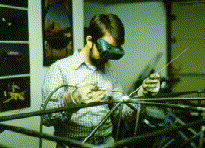Welding with Oxyacetylene
Oxyacetylene, commonly called gas welding, produces heat by burning oxygen and acetylene in the proper mixture flowing from the tip of a welding torch. The temperature at the tip is 6300 degrees. The metal is raised to a molten state and a rod is inserted in the puddle to add thickness to the seam. The extra thickness is required because the welded seam does not have the same grain structure as the original metal.
Many amatuer builders and the old timers use the gas welding process. It is an inexpensive way to weld as the equipment you need to buy is minimal. You can rent the tanks and buy the torches for reasonable cost. I chose the process partly for cost and because I was taught gas welding in A & P school and enjoyed it. It is a fun way to weld!
Welding with Heliarc
With Heliarc welding, the object is the same as gas welding, a wire rod is inserted into the molten puddle. But an electric arc is used to heat the metal through a tungsten rod held close to the metal. The weld area is shrouded by an inert gas to keep impurities out of the weld. Tungsten Inert Gas This is a much better way to weld but equipment cost is a big factor.
MIG welding has become a popular process for kit manufacturers. It is similar to TIG, but the center electrode is consumable. It feeds by operator control through the handle. The units are relatively cheap but many think it takes a special skill to get good, strong welds.
The Experimental Aircraft Association is a good source of information for anyone interested learning about welding. I found the best way to learn any of these welding processes is in your local community through adult education classes.
 Return
Return

